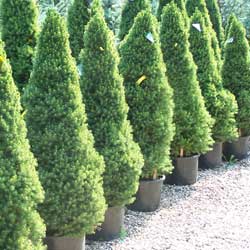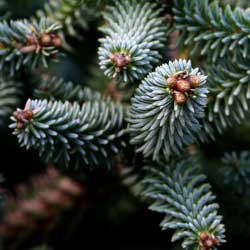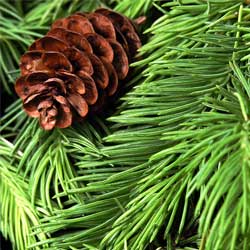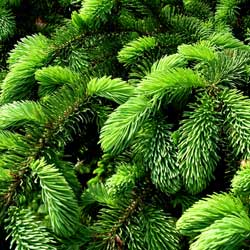As evergreen screens, windbreaks, and focal points they put a pop in a garden’s structure. We have three favorite conifers. Each is completely different from the others and each makes a visual statement.
First, you may be asking, “What is a conifer?” This is a group of trees or shrubs with modified leaves we usually call “needles” and instead of bearing flowers to produce seeds, the seeds develop in a “cone.” Most are trees, ranging from extremely tall to medium sized shrubs. Selective breeding and cultural practices, such as bonsai, produce dwarf sizes. The differences in needle color and configuration, cone shape and sizes and overall growth pattern make this a fascinating group of plants.
Therefore, without further ado, here are three unusual and outstanding conifers to consider…
The Coast Redwood, Sequoia sempervirens, a California native, rates in the “tallest tree” category by growing to over 350′ tall. However, in a normal landscape it stays much shorter. Use as a single specimen tree and underplant with woodland plants and ferns to create a forest vignette or plant 3-4′ apart and prune annually to produce a hardy hedge. This conifer doesn’t produce resin or pitch, therefore it’s resistant to fire. Because its bark is high in tannins, it has a natural resistance to insects and fungi. Garden centers offer cloned varieties with different colors, growing shapes and even dwarf forms.
The Weeping Blue Atlas Cedar, Cedrus atlantica “Glauca Pendula,’ doesn’t grow up…it just grows. Left unsupported it grows along the ground. Providing a support allows it to grow upwards. When it reaches the top of the support, it will “weep” downward unless another support, such as a fence, exists. Try growing in a large container and train along deck siding or lattice. Or, let it spill over a rockery. Another attraction of this plant is the silvery blue color of the needles. Growing against a darker colored background highlights its silhouette. Relatively pest free and drought-tolerant, this unusual addition to your garden definitely makes a statement.
Alberta Spruce, Picea glauca albertiana “Conica,” slowly grows into a cone-shaped bush, 5-7′ tall by 3-5′ wide. The soft bright green needles give it a clean and modern appearance. At this time of the year, consider planting in a container to use as a living Christmas tree. Tiny lights and decorations make this a stunning decorative touch. Outdoors, plant Alberta Spruce flanking garden entrances, bordering paths, and creating little “pops” of green accents in the landscape. They’re also stunning in outdoor containers.
There you have it, three unusual conifers available to make your personal garden statement.










